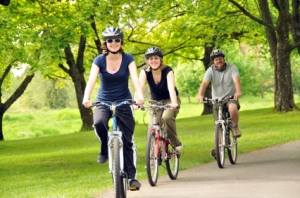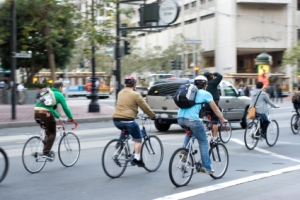Cycling is now one of the most popualr of exercise forms around.. Why??? Because it’s free of course! In fact you can actually make money if you give up the car a few days a week and cycle to work.
Cycling is the third most popular recreational activity in the UK. An estimated 3.1 million people ride a bicycle each month.
As a form of exercise, cycling has broad appeal. Toddlers, pensioners, able-bodied or disabled people can all enjoy cycling if they have the right equipment. For cycling tips for beginners and how to stay motivated, read the getting started guide to cycling.
Cycling is one of the easiest ways to fit exercise into your daily routine because it’s also a form of transport. That means it saves you money, gets you fit and contributes to a cleaner environment.
It’s a low-impact type of exercise, so it’s easier on your joints than running or other high-impact aerobic activities. But it still helps you get into shape.
For example, someone who weighs 80kg (12.6 stones) will burn more than 650 calories with an hour’s riding, and tone their legs and bottom. If you ride up hills or off-road, you’ll also work your upper body.
The best way to build your cardiovascular fitness on the bike is to consistently ride twice during the week, then do a longer ride at the weekend. You’ll soon feel the benefits.
 |
Lose weight and have fun with your friends! |
Cycling calendar
British Cycling’s recreation and travel sections offer information and hints on everything you need to enjoy cycling, whether you’re a commuter, mountain biker, ultra-fit road rider or first-time cyclist.The site includes a national leisure cycling calendar, which lists everything from charity events to multi-day challenges, plus advice on training, maintenance and improving fitness.
It has suggested routes for you to ride in your area, and a function where you can map where you’ve ridden, log the miles you’ve travelled, and rank yourself against other riders. You could join a club in your area and go on organised bike rides. To find a club, see the British Cycling website.
If you want to turn your hobby into something more competitive, there are around 2,500 races registered with British Cycling each year. There are all sorts of bike races to chose from. Visit the British Cycling recreation section to find a race near you that you can watch or take part in.
Safety tips
- Look behind you before you turn, overtake or stop.
- Use arm signals before you turn right or left.
- Obey traffic lights and road signs.
- Don’t ride on the pavement unless there’s a sign that says you can.
- On busy or narrow roads don’t cycle next to another person.
- When overtaking parked cars, watch out for car doors opening suddenly, and allow room to pass safely.
- Don’t use headphones while cycling.
- Never use a mobile phone while cycling.
Kit checklist
- Wearing a cycling helmet will significantly reduce your risk of serious head injury in an accident. For a proper fit, the helmet should fit snugly and shouldn’t allow any sideways movement.
- Before you ride, check that you have the right kit, and that your bike is in good working order.
- Make sure your tyres are pumped up. Test your brakes before you get on the road.
- Check that your saddle is at the correct riding position for your height. If your saddle is too low, it will make it more difficult for you to pedal and you’ll get tired more quickly.
- To get the right height, adjust the saddle until you can stretch your leg out and place the ball of your foot on the ground. This means that when your pedal is at its lowest position, your leg should be slightly bent. If your leg is completely straight when your pedal is at the lowest position, your saddle is too high.
- If you’re cycling after dark, it’s important that you can be seen by other road users. Wear reflective clothing and make sure the lights on the front and back of your bike are both working. Use your lights when visibility is low, such as in bad weather.
- Try and group together with colleagues at work and ride as a group. This is safer and you can chat about issues of the day and/or vent your anger at the days events – reducing stress and building comradery between work mates.
- If you can’t cycle as a group, why not join a local club? Just get onto google and type bike club and your area. No matter where you live there are hundereds up and down the country – there will be one. It’s a great way to meet people from all sorts of backgrounds – people you would never normally meet.
- For bike routes go to your local tourist information, try the sustrains website or www.bikeradar.com for routes discovered and upoaded by local riders.
- Plan you own routes using http://bikeroutetoaster.com/
 |
Cycle To Work |
Get some decent bike security. The more you ride the more important the bike will become to you, so if it’s stolen the inconvenience will be horrendus. For Bike Security and bike storage advice try www.asgardsss.co.uk
Source: Information courtesy of www.nhs.uk
0 comments:
Post a Comment